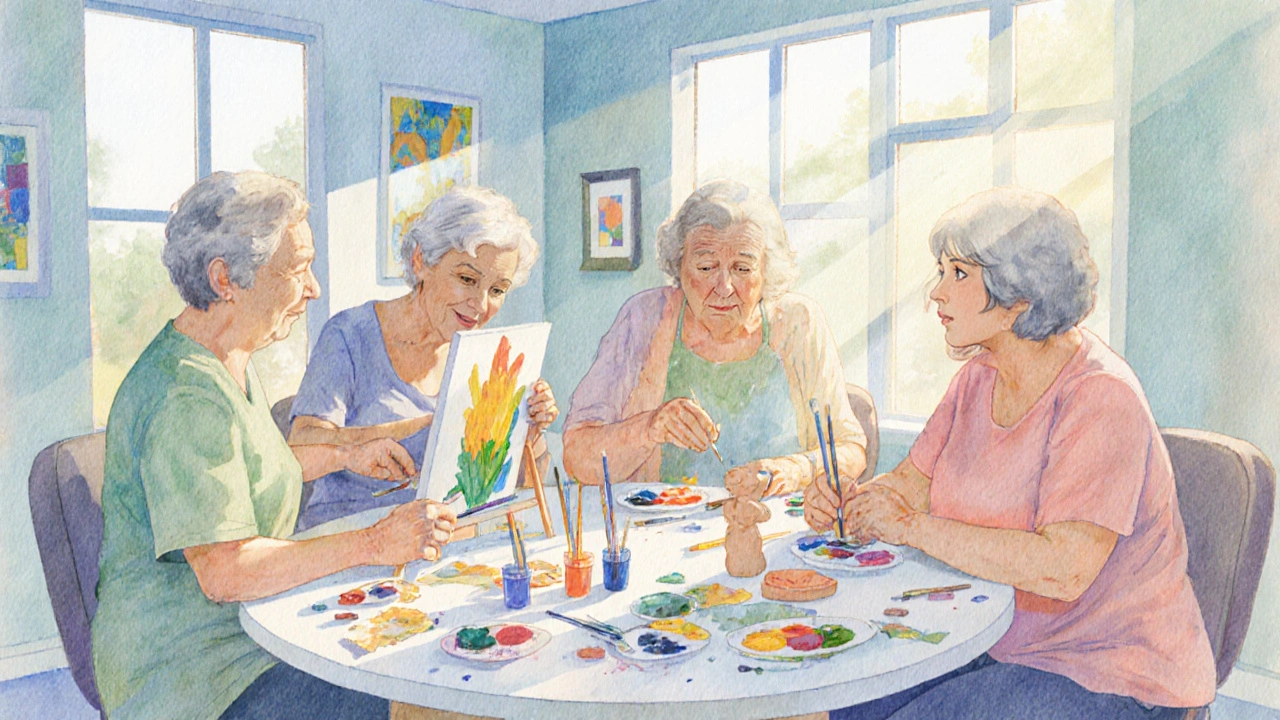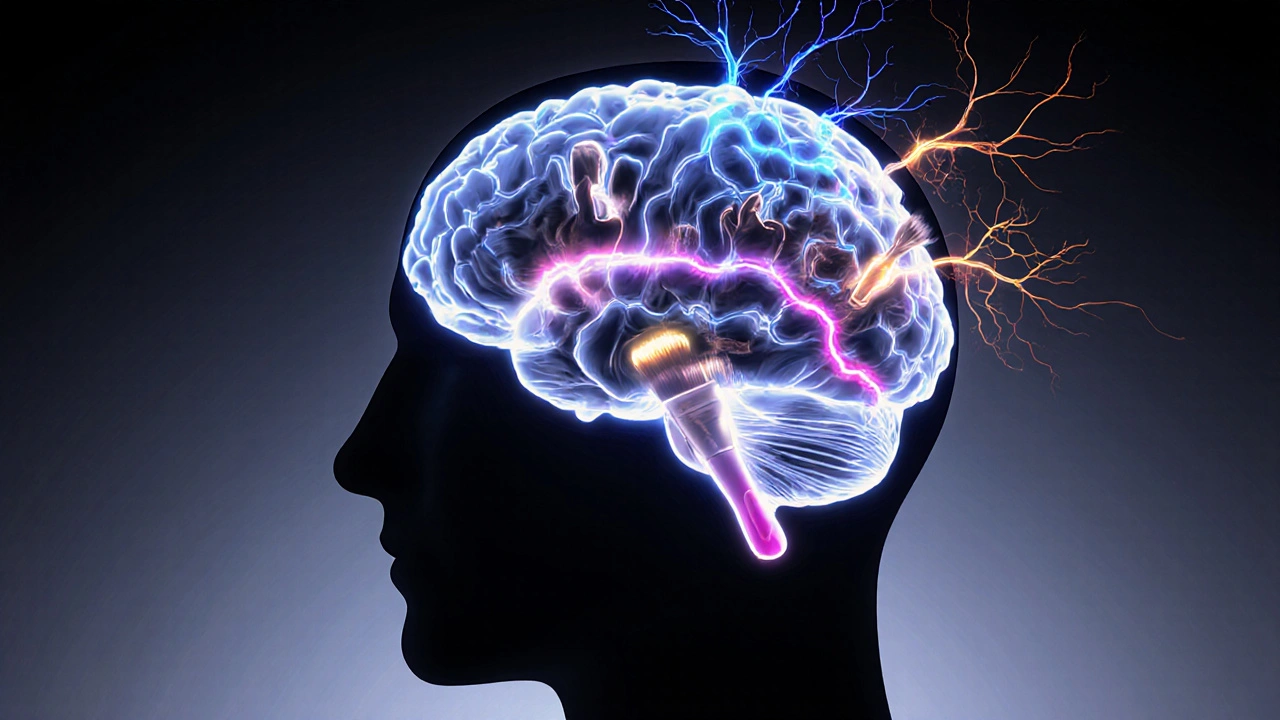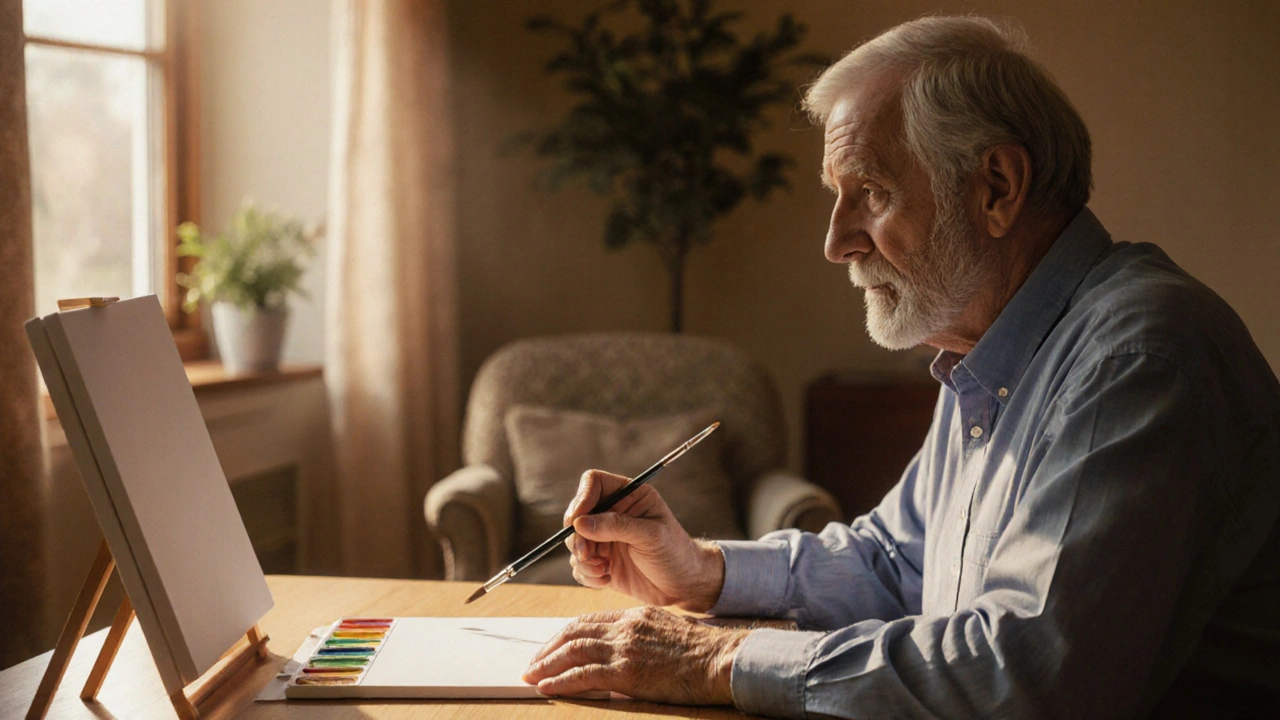Parkinson's Art Therapy Impact Calculator
Estimated Impact of Art Therapy
How It Works
This calculator estimates the potential benefits of art therapy based on:
- Frequency of sessions: More frequent sessions typically yield greater improvement
- Daily practice: Consistent home practice reinforces gains
- Baseline symptoms: Initial UPDRS score affects potential improvement
- Quality of life baseline: Higher starting points may see smaller relative increases
Note: These estimates are based on research showing average improvements in clinical trials for Parkinson's patients participating in art therapy programs.
Living with Parkinson's disease can feel like your body is on a slow, unpredictable treadmill. You might notice tremors, stiffness, or those dreaded "off" moments when movement becomes a struggle. While medication targets the chemical imbalance, many patients wonder if there’s something more tactile, something that speaks to the mind‑body connection. That’s where art therapy steps in, offering a hands‑on way to improve motor control, mood, and overall quality of life.
What is Art Therapy?
When we talk about art therapy as a guided creative process that uses drawing, painting, collage, or sculpture to support emotional and physical healing, the goal isn’t to create a masterpiece. Instead, a certified therapist helps patients use visual expression to explore feelings, practice fine motor skills, and engage brain pathways that medication alone may not reach.
Parkinson's Disease: A Quick Overview
Parkinson's disease is a progressive neurodegenerative disorder that primarily affects movement by depleting the brain chemical dopamine. The loss of dopamine leads to the classic motor symptoms-tremor, rigidity, bradykinesia (slowness), and postural instability-and also fuels non‑motor challenges like anxiety and cognitive decline.
Why Creative Work Helps the Brain
Research shows that any activity that challenges the brain can stimulate neuroplasticity-the brain's ability to reorganize and form new connections. When a Parkinson’s patient lifts a paintbrush, they’re not just making a splash of color; they’re recruiting motor circuits, visual‑spatial networks, and emotional centers-all at once. This multisensory engagement can partially offset the dopamine deficit by encouraging alternative pathways.

Key Benefits of Art Therapy for Parkinson’s Patients
- Improved motor control: Repetitive hand movements strengthen fine‑motor muscles, making everyday tasks like buttoning a shirt easier.
- Reduced tremor severity: Focusing on a creative task can temporarily calm tremors, similar to the way rhythmic music reduces shaking.
- Enhanced cognition: Planning a composition or selecting colors exercises executive function, which can slow cognitive decline.
- Boosted mood: Creating art releases endorphins and offers a safe outlet for frustration, anxiety, or depression.
- Better social connection: Group sessions foster peer support, reducing the isolation many patients feel.
- Higher quality of life: When patients feel capable and expressive, their overall satisfaction with daily life climbs.
How a Typical Art Therapy Session Looks
- Welcome and check‑in: The therapist asks about recent symptoms and mood to tailor the session.
- Warm‑up exercise: Simple drawing drills (e.g., tracing shapes) warm up the hand and focus the mind.
- Creative activity: Patients choose a medium-watercolor, clay, collage-and work on a theme (emotion, memory, or a personal story).
- Reflection: After the artwork is finished, the therapist guides a short discussion about feelings, challenges, and successes.
- Home practice plan: Simple at‑home tasks (like sketching for 5 minutes daily) are suggested to reinforce gains.
Science‑Backed Evidence
A 2023 randomized controlled trial involving 120 participants with moderate Parkinson’s showed that 12 weeks of weekly art therapy reduced Unified Parkinson’s Disease Rating Scale (UPDRS) motor scores by an average of 4.2 points compared with a control group receiving standard physiotherapy alone. Cognitive tests (Montreal Cognitive Assessment) improved by 1.6 points, and participants reported a 20% rise in self‑rated quality of life.
Another pilot study from the University of Toronto highlighted that art‑making increased serum brain‑derived neurotrophic factor (BDNF), a protein linked to brain health and plasticity. While the sample size was small (30 patients), the findings suggest a biochemical pathway for the observed functional benefits.
Art Therapy vs. Traditional Physical Therapy: A Quick Comparison
| Aspect | Art Therapy | Physical Therapy |
|---|---|---|
| Primary focus | Creative expression, emotional processing | Movement mechanics, strength |
| Motor skill benefit | d>Fine‑motor coordination; hand‑eye integrationGross‑motor strength; balance | |
| Cognitive engagement | Planning, problem‑solving, visual‑spatial reasoning | Repetition of movement patterns |
| Emotional impact | High - reduces anxiety, depression | Moderate - can improve mood via activity |
| Social component | Group sessions encourage shared storytelling | Often one‑to‑one |

Finding the Right Program
Start by asking your neurologist or local hospital if they partner with a certified art therapist. Many community centers, senior living facilities, and Parkinson’s support groups run weekly workshops. When evaluating options, consider:
- Therapist credentials (look for a board‑certified art therapist with experience in neuro‑rehabilitation).
- Session size - small groups (4‑6 people) allow more individualized feedback.
- Material accessibility - programs that provide supplies reduce barriers.
- Flexibility - virtual options can be helpful for those with mobility constraints.
Tips for Caregivers
Caregivers play a vital role in sustaining the benefits. Encourage patients to keep a simple art journal, celebrate even tiny creations, and join them in a session when possible. Remember, the goal isn’t perfection; it’s movement, expression, and the sense of achievement that comes with finishing a piece.
Key Takeaways
- Art therapy offers a multisensory route to improve motor control, cognition, and mood.
- Scientific studies show measurable gains in UPDRS scores and quality‑of‑life ratings.
- It complements, not replaces, medication and traditional physiotherapy.
- Finding a qualified therapist and maintaining regular practice are essential for lasting impact.
Frequently Asked Questions
Can art therapy replace medication for Parkinson’s?
No. Medication remains the cornerstone for managing dopamine loss. Art therapy is an adjunct that can enhance motor function, mood, and quality of life alongside drug treatment.
Do I need prior artistic skill to join?
Not at all. The therapist tailors activities to each skill level. The emphasis is on expression, not technique.
How often should I practice art therapy?
Most programs recommend weekly guided sessions plus a short home practice (5‑10minutes) on non‑session days to reinforce gains.
Is virtual art therapy effective?
Yes, especially for those with limited mobility. Video‑based sessions can still provide real‑time feedback and social interaction, though tactile mediums may be harder to share.
What should caregivers watch for during sessions?
Monitor fatigue, ensure the environment is safe (no slip hazards), and watch for signs of frustration. Positive reinforcement helps keep the experience uplifting.

Amy Aims
October 10, 2025 AT 23:04What a wonderful overview! Art therapy really does seem like a bright spot for folks battling Parkinson's, offering both hands‑on movement and a creative outlet. Keep sharing these hopeful stories 😊
Shaik Basha
October 14, 2025 AT 10:24Totally agree with the vibe here, dude! The whole brush‑waving thing is like a workout for ya brain and hands, and it ain\'t about bein\' Picasso. Gotta love that vibey mix of art + science, ya know?
Michael Ieradi
October 17, 2025 AT 21:44While the article presents an optimistic perspective, it is essential to acknowledge that the cited improvements, though statistically significant, represent modest gains in clinical terms. Patients should maintain realistic expectations regarding the magnitude of benefit.
Stephanie Zuidervliet
October 21, 2025 AT 09:04Art therapy-miraculous, transformative, and absolutely life‑changing!!!
Aayush Shastri
October 24, 2025 AT 20:24I appreciate the inclusive tone of this piece, especially the nod to community‑based programs that respect cultural nuances. In many South Asian families, artistic expression is woven into daily rituals, and integrating therapy can feel quite natural.
Quinn S.
October 28, 2025 AT 07:44Frankly, the article’s claim that art therapy can "significantly" reduce UPDRS scores is an overstatement; the data merely indicate a marginal reduction, which does not justify broad clinical endorsement without further rigorous trials.
Dilip Parmanand
October 31, 2025 AT 19:04Give it a try for ten minutes a day-consistent doodling can boost confidence and fine‑motor control without breaking the bank.
Hannah Gorman
November 4, 2025 AT 06:24When one first encounters the notion that a simple act of placing pigment upon canvas could serve as a therapeutic conduit for Parkinson’s disease, the mind instinctively recoils with a blend of skepticism and curiosity. Yet, as the literature meticulously documents, the neuroplastic potential inherent in multisensory engagement should not be dismissed as mere anecdote. The very act of gripping a brush, manipulating its tip, and navigating the tactile resistance of paint stimulates the corticospinal pathways in a manner akin to conventional physiotherapy, but with the added benefit of emotional catharsis. Moreover, repeated artistic endeavors cultivate executive function by demanding planning, sequencing, and deliberate decision‑making-cognitive processes often compromised in dopaminergic decline. Ongoing trials, particularly the 2023 randomized controlled study involving a cohort of 120 participants, have demonstrated an average reduction of 4.2 points on the Unified Parkinson’s Disease Rating Scale, a statistically meaningful shift when juxtaposed against standard care. Not to be overlooked is the concomitant rise in serum brain‑derived neurotrophic factor, a molecular harbinger of synaptic resilience, observed in the smaller Toronto pilot. One must also consider the psychosocial dimension: group sessions engender camaraderie, dispelling the isolation that frequently shadows neurodegenerative diagnoses. Furthermore, the aesthetic pleasure derived from creating can trigger endogenous opioid release, subtly ameliorating mood disturbances that often co‑occur with motor deficits. While art therapy does not supplant dopaminergic medication, it serves as a valuable adjunct, filling niches left untouched by pharmacologic intervention. Practitioners should, however, remain vigilant to ensure that the creative process does not devolve into frustration, which could inadvertently exacerbate anxiety. Caregivers play a pivotal role in fostering an environment where experimentation is celebrated, not judged, thereby preserving the therapeutic spirit of the activity. In sum, the interdisciplinary convergence of neurology, psychology, and the visual arts offers a promising, albeit still emergent, avenue for holistic patient care. Continued longitudinal research will be essential to delineate optimal dosage, modality selection, and long‑term outcomes, cementing art therapy’s place within the standard therapeutic armamentarium for Parkinson’s disease.
Tatiana Akimova
November 7, 2025 AT 17:44Listen, folks-if you’re looking for a tangible boost, dive into a short daily sketch. It sharpens those trembling fingers and the brain loves the challenge. Don’t overthink it; just start and feel the momentum.
Calandra Harris
November 11, 2025 AT 05:04Art therapy works because the brain is adaptable and the act of creating engages multiple neural circuits; this is a fundamental truth that transcends cultural biases and should be universally embraced
Dan Burbank
November 14, 2025 AT 16:24One must interrogate the epistemological underpinnings of such therapeutic claims. While the empirical data hint at modest improvements, the romanticization of brushstrokes as panacea borders on intellectual complacency. A discerning practitioner ought to integrate these modalities with a judicious awareness of their limitations, lest we succumb to a veneer of artistic idealism that obscures rigorous scientific discourse.